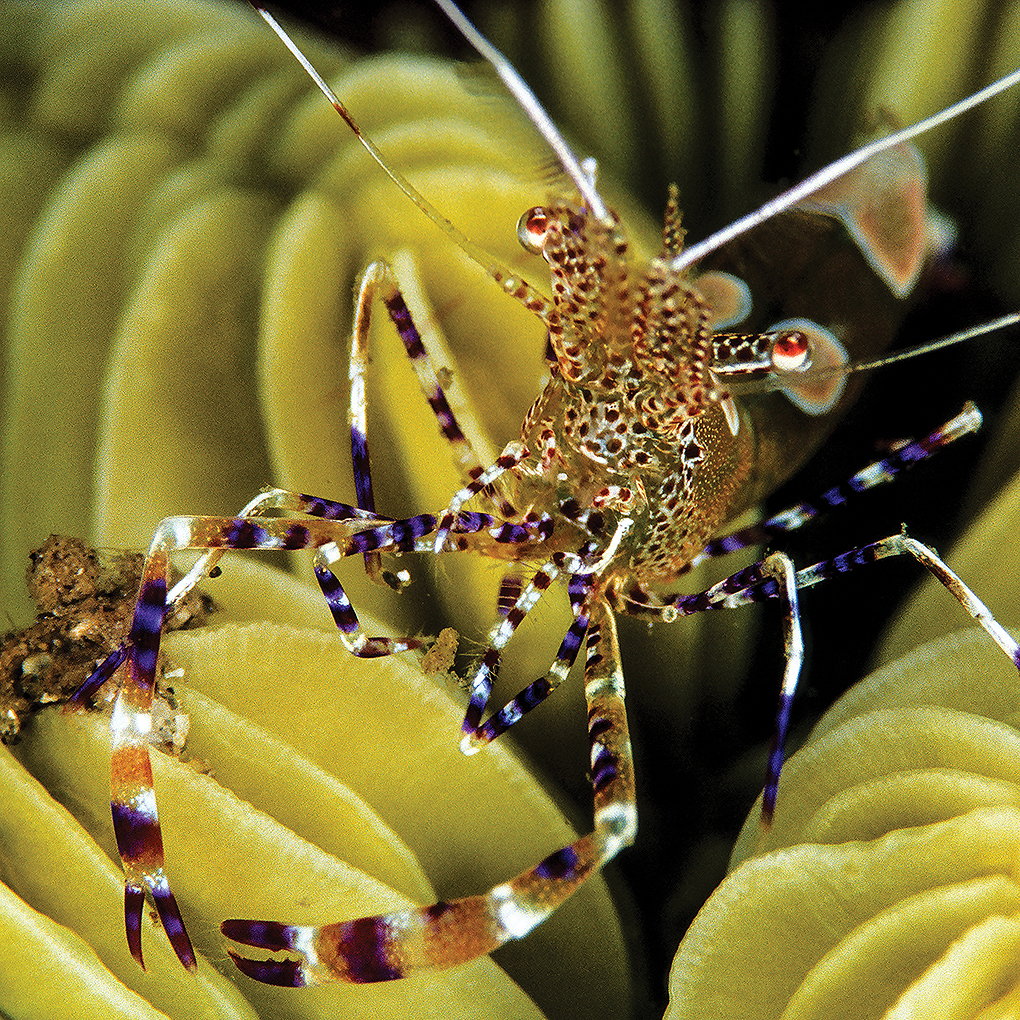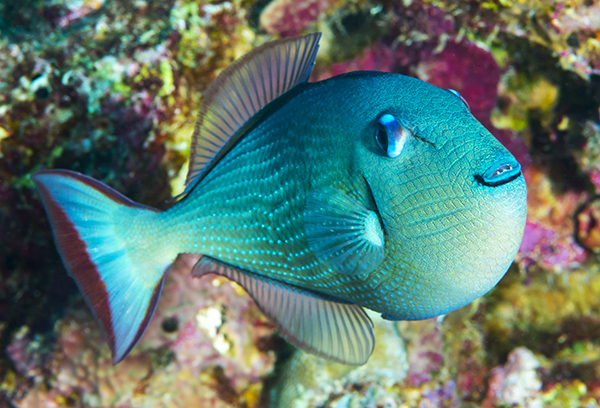
Small, red-eyed Holthuis’s Commensal Shrimp, Ancylomenes holthuisi, on a mushroom coral, Fungia sp. Taken in Lembeh Strait, North Sulawesi, Indonesia. Image by Larry P. Tackett/REEF LIFE Calendar 2020.
Holthuis’s Commensal Shrimp
Ancylomenes holthuisi (Bruce, 1969)
Synonyms: Periclimenes holthuisi
Order: Decapoda
Range: Indo-West Pacific
Size: To about 1 inch (2.5 cm)
Depth: 3-100 ft. (1-30 m)
This tiny decapod (ten-legged) shrimp lives with sea anemones and coral colonies and sometimes hitchhikes into the aquarium trade. Grows to a length of about one inch (2.5 cm). Somes called the Anemone Shrimp. Will feed on stray bits of meaty foods.

Blue Throat or Gilded Triggerfish (Xanthichthys auromarginatus), female. Found at Mauritius to Hawaii, and New Calendonia to Ryukyu Islands. Photo taken at Christmas Island, Australia.
See the January/February 2019 Issue of CORAL for Scott Michael’s profile of this and other reef-safe triggerfishes. Most require a large system but are planktivores that will ignore aquarium corals and most ornamental invertebrates. Image by Gary Bell © Oceanwide Images.com

Unknown fisherman with Humphead or Napoleon Wrasse, Cheilinus undulatus.
This amazing image is making its viral way around various fishing internet sites with no information about the time, place, or the identities of fisherman or photographer. If you know, please let us know.
The fish itself is a magnificent example of a Napoleon or Humphead Wrasse, the largest member of Labridae family. It grows up to 229 cm (7.5 feet) and 191 kg (483 lbs) and is reported to live to 32 years of age or older. This iconic marine predator ranges from East Africa and the Red Sea to Southern Japan and New Caledonia, east of Australia. (Some sources also call this species the Giant Wrasse, Maori Wrasse, Truck Wrasse, or Undulate Wrasse.)
Whatever its common name, Cheilinus undulatus is overfished for the Asian live fish restaurant trade and listed as an Endangered Species. Small juveniles are very occasionally seen in the aquarium trade. Aquaculture efforts may eventually help restock regional fisheries and restore some wild populations. We can hope this admirable specimen was released.
More Information




The max size often cited is almost certainly too large. It was based on Marshall, 1965 Fishes of the Great Barrier Reef but the trail runs cold and no one has been able to confirm his source. Since the last Redlist listing, Choat who has done some digging as well as sampled hundreds in markets over the years, disputes this and gives a more plausible max length of 170 cm corresponding to a weight of somewhat over 45 kg (100 lbs). I will revise my future books accordingly.
Impressive, though and I sure hope the fish in the photo was released!
Anyone interested, consult Choat et al, 2006. Age structure and growth in a large teleost, Cheilinus undulatus, with a review of size distribution in labrid fishes. Marine Ecology Progress Series 318:237-246. In that paper he gives 140 cm as the maximum based on what he sampled. The 170 cm I mentioned earlier is based on Randall, 2007, Reef and Shore Fishes of the Hawaiian islands, citing further communication with Choat.
Hi Rob,
This is valuable information, and I would like to publish it in the next print issue of CORAL. Perhaps we can get Jack Randall to comment as well. (He has a great article in that issue, as it happens.) Scott Michael will also be interested in this as a possible revision to his books.
This vessel appears to belong to a charter company in New Caledonia, Blue Caledonie Fishing. Not only should they know of the protected status of the maori wrasse but should know this adult male should never have been landed/handled.
Cheers
Good Call there….sad to me to see that
The vessel appears to be from a charter company in New Caledonia…Blue Caledonie Fishing. Perhaps they know the name of the fisherman. They certainly should know of the protected status of the maori wrasse and nevee should have allowed this adult male specimen to be landed.
The biggest Maori Wrasse (C. undulatus) that we have provided to a public aquarium for educational purposes under strict permitting from the Australian government and Cites certification, was 60kg. Prior to the species being protected in Australia, there is a record of one being speared in the Coral Sea at 60kg also. I have personally seen them a lot bigger than this. Based on the examples I have seen and handled at a range of sizes and at 60 kg, I would estimate the true giants being in excess of 100kg. I have seen one this size on the great barrier reef and three swimming blue water off the walls in the coral sea that drop off to over 1000 meters. They are by far the most intelligent fish I have ever worked with and every one has a very distinct personality. In the coral sea, it is a common occurrence to see up to 10 or more in a dive.
Are found here in Guam where it is still legal to spear them but cannot sell nor ship them. Several big males around the island on west side reefs, unknown on east side due to dangerous diving conditions throughout the year. See juvenile “tanguisson” regularly in the lagoon areas up to 12 individuals in an hour especially in the preserves, from 3” up to about 14-18” before they begin to change color and I assume head to deeper water.
Very shy and wary here which is a good thing. Article several years ago claimed first captive breeding but little details. Anyone know more?? Please contact me. These are incredible fish!!!
Its great to get this feedback. I rarely do social media, too much email as it is but if anyone would like to communicate directly with me, here is my address: robmyers1423@gmail.com. Good to get some perspective from Lyle Squire and Robert Hildreth. I know that true ‘giants’ are so very hard to document and often the subject of speculation, no thanks to the many ‘fish stories’ out there. I would like to bring Howard Choat in on this discussion as true maximum size is essential for good fishery management and conservation. I personally am not surprised at 60+ kg fish and consider 100 kg plausible, would love to see documentation! 47 kg is about the max I recall from specimens landed at Guam’s coop; they may have records of larger ones. From conversations with a number of old-time spearfishers, they claimed up to 150 lbs (68 kg) and that another giant, the parrotfish Bolbometopon muricatum gets even larger. A photo was on display under the coop counter with one being held up that weighed in at 152 lbs (69 kg). I don;t know the fate of that photo. I will send this link to a former colleague at Guam fisheries who may be able to dig into this.
This picture makes me so angry why don’t they leave these beautiful creatures alone! I’m an aquarist although I love them very much and I know they should be left in their natural habitat, as to why I left the hobby completely because I can’t stand to see these beautiful creatures die in captivity! Please leave them alone!
A reverse image search brought me to Instagram, with this caption –
“@fishing_worldgram
That thing is HUGE! Tag someone who looks like this fish! Do you know what this giant catch is?! It was released safely! These fish cannot be kept
Caught by Riccardo Peri
Tag a friend! Follow @waypointtv.fishing for more”
The man in the photo is @Riccardo_Peri, It was said in the original photo caption that he caught and released the fish safely.